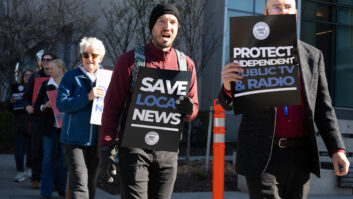The Issue of localized content delivered via satellite radio stirs debate.
The recent addition of local content (or plans for it) by satellite radio service providers has re-ignited the wrangling over what regulation should allow or disallow in the space.
Current regulation has framed the distinction between national vs. local service along technical boundaries, in that terrestrial repeaters can only transmit content relayed from the satellite feed; there can be no uniquely generated local content carried by the repeater.
The new local traffic and weather services carried or planned by satellite radio do not violate this rule, of course. They are transmitted via satellite in the same manner as any other channel on the service, and are treated as national signals, even though they contain local information. In other words, if an XM listener in San Diego wanted to hear Philadelphia traffic information, all it would take is tuning to the appropriate channel.
Those who argue that the FCC should not allow this are therefore asking the commission to cross the line into regulating the content of a service, something that the agency generally is loathe to do without extremely compelling reasons (other than issues of indecency, which have seen their own upswing in interest recently; but that’s another story).
The real argument is, of course, about money. Local broadcasters are worried that satellite radio now can viably sell advertising time on these localized content channels, potentially picking the pockets of local stations.
New territory
This is not the first time that the FCC has been involved in the fray between satellite and terrestrial broadcasters over local content. Regulatory activity for satellite and cable television operators on this subject is well known. Yet the satellite radio discussion differs in several significant respects.
First, in satellite television, local terrestrial TV stations may be delivered by the satellite service provider, and the subscriber may be charged an additional monthly fee for the service. This allows satellite TV to compete more favorably with cable services, which always carry local stations (as mandated by “must-carry” rules), but satellite providers’ spectrum budgets have limited this service to subscribers in the top 50 to 75 markets to date. Regulations covering such “local-into-local” service require satellite TV operators to carry all full-power TV stations in any market they serve – the so-called “carry-one, carry-all” rule.
Another important difference is that subscribers are limited by conditional access systems to receiving only their markets’ local stations. This protects the local broadcasters’ access to their native viewing audience.
Most different, however, is that these services are simply repeated from local stations, and the satellite providers have no ability to sell time on these channels. Contrast this to satellite radio, where the new local services are original, created by the satellite operator, so any decisions on content (including possible advertising) for these channels remain the satellite provider’s own.
How it’s done
Naturally, this comes at some substantial cost to the satellite operator. Again in contrast to satellite TV, where most of the cost of offering local service comes simply from the backhaul of terrestrial TV signals to a satellite uplink, satellite radio’s local services are live-assembled from data purchased from various traffic and weather reporting agencies.
The weather data is streamed as text onto the appropriate market’s local info channel for display on the receiver’s data screen. Meanwhile, announcers record traffic reports, reading info delivered to their PC screens by local traffic data services. XM’s announcers for this service handle three markets apiece, each from a separate studio, with a PC-based automation system programmed to continually feed the most recently recorded report(s) to the appropriate channel’s audio input.
As is its wont, XM will not divulge the data rates used to deliver any of its services, but simply reports that it is quite low per market served. This implies that bandwidth is not the limiting factor to adding future service for more markets, but rather that the cost of acquiring and assembling the services will have to be balanced for the viability of such expansion.
At present the operators seem to consider this an experiment. Depending on the return received – either from additional subscribers (or a possible future tiered-fee structure?) or from possible future local ad sales — satellite radio providers could choose to scrap these services, keep them at their initial size or expand the number of markets served.
Framing the argument
The rhetoric has heightened on both sides of this debate since satellite radio announced its localized content intentions. For example, U.S. Rep. Billy Tauzin, R-La., who recently retired as House Commerce Committee chairman, has often made note of his opposition to any local service being provided by satellite radio. While his earlier pronouncements regarded use of the terrestrial repeater network, he has recently extended his comments to include local content delivered by any means, decrying satellite radio’s intent to compete directly with “small radio broadcasters.”
On the other hand, in a widely cited essay in the online magazine Slate, a former chief economist of the FCC, Thomas Hazlett, has called for the commission to drop its “absurd” rules that prohibit satellite radio’s terrestrial networks from delivering local content, claiming that the need for a workaround by delivering these channels nationally is inefficient and wasteful of spectrum.
There are potential flaws with both of these arguments. First, the “small broadcasters” Tauzin cited generally no longer exist in the markets served with local content by the satellite operators, where practically all stations are part of a consolidated group. So it can be said that both satellite and terrestrial radio services are provided by multi-channel operators in these markets.
Meanwhile, regarding Hazlett’s recommendation that terrestrial repeaters be used for delivering local content, it is not clear that enough repeaters exist to provide this service adequately on both XM’s and Sirius’s networks.
Of course, more terrestrial transmitters could be added – both services have permission on their existing STAs to operate more repeaters than they have built to date – but it might not be worth the expense to install and maintain them simply to include local content, where satellite coverage alone is already deemed sufficient.
(Hazlett’s premise brings to mind the extreme position held by some that, in such hybrid sat/terr systems, the satellite is simply a loss leader required for the licensee to gain access to the spectrum, which is then primarily addressed by terrestrial extensions. The satellite serves as a cost-effective “STL” to the distributed terrestrial network, with the additional but relatively minor value of directly addressing rural zones.)
The stakes are sky-high
Finally, consider that what the satellite operators are providing is not really a directly competitive replacement for traffic and weather content offered by local terrestrial radio services. In fact, the full-time localized audio and text services provided by satellite radio are a major step beyond terrestrial radio’s offerings, which are necessarily abbreviated and only occasionally inserted into other audio content. Listeners have to wait until the broadcaster deems it appropriate to transmit such data, by which time the traffic data often is outdated. Terrestrial broadcasters will not be able to offer matching service until substantial proliferation of IBOC (and “Tomorrow Radio”) receivers occurs, meaning that satellite radio will maintain an advantage here for several years to come.
It’s unlikely that this debate will soon subside. Rather, it could easily accelerate and become a centerpiece of the regulatory discussion on digital radio going forward. More important, it may also become a key criterion of listener choice.







